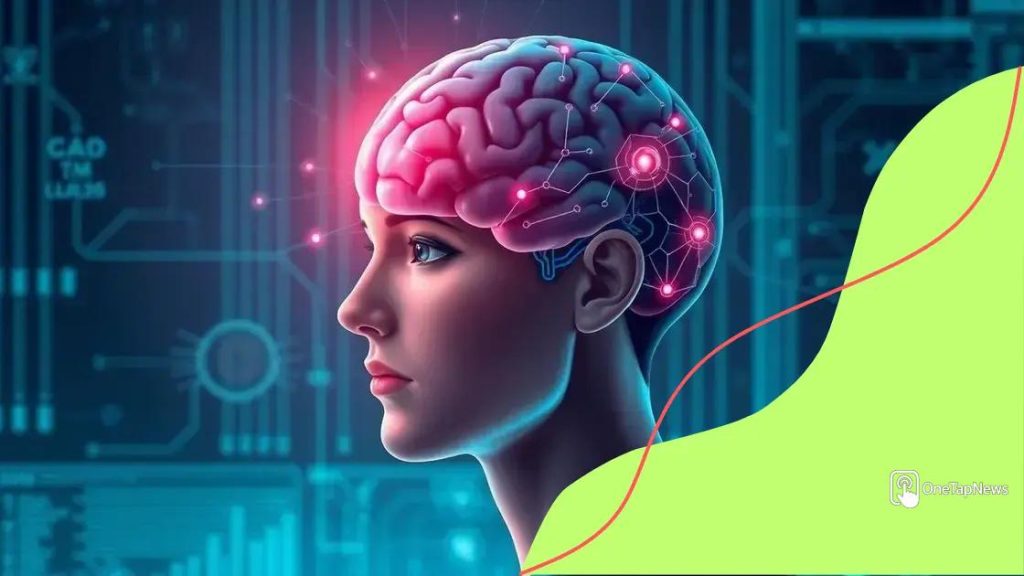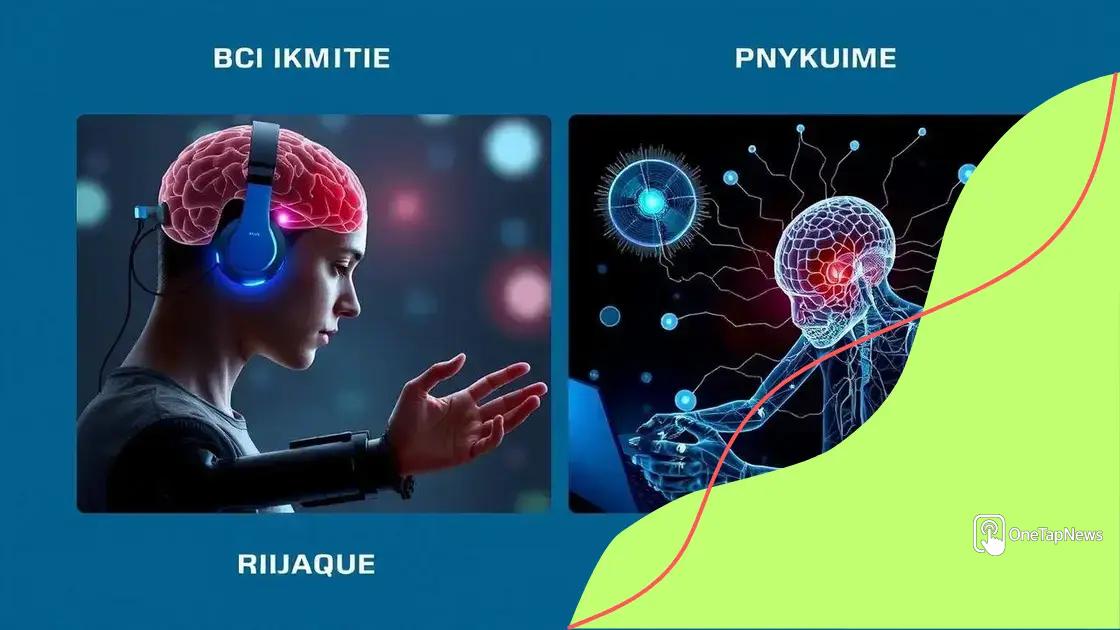Neuralink and brain-computer interfaces: a new frontier

Anúncios
Neuralink and brain-computer interfaces (BCIs) enable direct communication between the brain and devices, with applications in healthcare, cognitive enhancement, and various industries, despite facing ethical and technical challenges.
Neuralink and brain-computer interfaces are at the forefront of technological innovation, revolutionizing the way we think about communication and interaction. Have you ever imagined controlling devices with just your thoughts? This article will explore the fascinating world of BCIs and their implications for our future.
Anúncios
What is Neuralink and how does it work?
Neuralink is a cutting-edge technology that aims to create a direct interface between the human brain and computers. This innovative concept opens new doors for communication and interaction. By allowing the brain to communicate with external devices, Neuralink is set to revolutionize various fields including medicine and entertainment.
How does Neuralink work?
The core technology behind Neuralink involves implanting tiny electrodes into the brain. These electrodes are designed to read and transmit neural signals, making it possible to control devices without physical movement. This brain-computer interface (BCI) uses advanced algorithms to interpret the data collected from the brain activity.
Key components of Neuralink
- Electrodes: Small, flexible threads that monitor brain activity.
- Robot surgeon: A specialized robot that implants the electrodes with precision.
- Device: A small chip that processes and wirelessly transmits data.
As the electrodes collect data, they can help individuals regain lost functions. For example, a person suffering from paralysis might be able to control a robotic arm or even a computer cursor by simply thinking about it. This approach has the potential to change lives, transforming how we think about rehabilitation and human capability.
Anúncios
Research on Neuralink has shown promising results in animal studies, indicating that this technology can be both safe and effective. However, many experts continue to study the long-term implications and effectiveness in humans. Ethical concerns, such as privacy and accessibility, are also critical topics in the discussion surrounding Neuralink.
The potential of Neuralink
The possibilities are nearly endless. Imagine enhancing cognitive functions or even improving memory through direct connectivity to digital systems. The reality of controlling home automation or even interacting with augmented reality could soon become a norm, blurring the lines between human abilities and technology. Enthusiasts and skeptics alike are captivated by what Neuralink might mean for the future of humanity.
The science behind brain-computer interfaces
The science behind brain-computer interfaces (BCIs) is fascinating and complex. At its core, BCI technology enables direct communication between the brain and external devices. This connection is achieved through sensors that pick up electrical signals from neurons. Understanding how these signals work is key to realizing the potential of BCIs.
How BCIs interpret brain signals
Neurons in the brain communicate through electrical impulses. When neurons fire, they create patterns that can be recorded by electrodes placed on or in the brain. These recorded signals are then processed by algorithms that convert them into messages that computers can understand.
- Neural Encoding: This process involves translating the brain’s signals into commands.
- Signal Processing: Algorithms clean and decode the raw data from neural activity.
- Feedback Loop: Users can receive feedback from the devices, allowing for adjustments based on their thoughts.
BCIs are designed to interpret these signals in real-time. This capability allows individuals to control devices just by thinking about them. For instance, a user can move a cursor on a screen or control a robotic limb without any physical movement.
Types of brain-computer interfaces
There are two main types of BCIs: invasive and non-invasive. Invasive BCIs involve surgical implantation of electrodes directly into the brain, while non-invasive options use external electrodes on the scalp. While invasive systems tend to provide clearer signals, they also carry higher risks. Non-invasive systems are safer but may have limitations in accuracy and speed.
Research is ongoing to improve the effectiveness and safety of both types. Innovations in materials and technologies are making it possible to create BCIs that are not only more accurate but also more accessible to a wider audience.
The impact of neuroscience on BCI development
Neuroscience plays a crucial role in advancing BCI technology. By understanding how the brain functions, researchers can develop better interfaces that align with human cognitive processes. Collaborative efforts between neuroscientists and engineers continue to push the boundaries of what is possible, bringing us closer to the dream of seamlessly integrating human thought with technology.
Potential applications of brain-computer interfaces

The potential applications of brain-computer interfaces (BCIs) are vast and exciting. These innovative technologies have the power to transform various industries, including healthcare, gaming, and communication. By allowing direct interaction between the brain and computers, BCIs open doors to new opportunities that were once only imagined.
Healthcare advancements
One of the most promising fields for BCIs is healthcare. They can assist individuals with mobility impairments by enabling them to control prosthetic limbs or wheelchairs using their thoughts. For example, patients with spinal cord injuries can regain some level of independence through these systems.
- Neurorehabilitation: BCIs can help retrain the brain after injuries such as strokes.
- Communication aids: Individuals with conditions like ALS can communicate using BCIs.
- Pain management: BCIs may offer new ways to manage chronic pain through neural modulation.
As technology advances, we may see even more applications in medical practices, offering solutions that enhance patients’ quality of life.
Impact on gaming and entertainment
The gaming industry is another area where BCIs are making waves. Imagine playing video games simply by thinking about the actions you want to take. The immersive experience would dramatically change how players interact with games, creating a direct link between thoughts and actions.
With BCIs in gaming, developers can design new experiences that are tailored to individual players, making each session unique and engaging. This level of personalization can enhance user engagement and satisfaction.
Enhancing communication
Moreover, BCIs hold promise in enhancing communication for people with severe disabilities. For those unable to speak or type, BCIs can facilitate conversation through thought alone. These systems can translate neural signals into speech or written words, offering new ways for individuals to express themselves.
This ability to communicate effectively can significantly improve emotional well-being and social interactions, reducing feelings of isolation.
Military and defense applications
In the military field, BCIs are being explored for improving operational effectiveness. Soldiers might use BCIs for enhanced situational awareness or to control unmanned vehicles with their thoughts, increasing efficiency and safety in missions.
The potential applications of brain-computer interfaces are only beginning to unfold. As research continues, we can anticipate even more innovative uses that could change our daily lives in profound ways.
Challenges faced by Neuralink and BCI technology
The challenges faced by Neuralink and BCI technology are significant and complex. As this innovative technology aims to bridge the gap between human thought and machines, several hurdles must be addressed to ensure success and safety.
Ethical considerations
One of the most pressing challenges involves ethical concerns. Questions about privacy, consent, and the potential for misuse of technology arise. It is vital to establish guidelines that protect users while promoting advancements in BCI technology.
- Data privacy: Protecting user data from unauthorized access is crucial.
- Informed consent: Users must fully understand the risks before participating in BCI trials.
- Potential biases: Ethical concerns about who has access to the technology need to be addressed.
Addressing these ethical issues will be essential for gaining public trust and acceptance.
Technical challenges
Another area of concern is the technical aspect of BCIs. Creating devices that are both reliable and effective presents many challenges. The electrodes must be capable of accurately reading brain signals without causing damage or discomfort.
Furthermore, the algorithms need to be sophisticated enough to interpret these signals accurately in real time. Issues such as signal noise and interference can complicate these processes, making it difficult to achieve precise control.
Regulatory hurdles
As BCI technology progresses, navigating regulatory environments becomes increasingly complex. Ensuring compliance with safety standards while pushing for innovation can slow down developments. Regulations can vary significantly across different regions, further complicating the landscape for companies like Neuralink.
With the rapid pace of technology, regulatory bodies must adapt and create frameworks that support innovation while maintaining safety.
Public perception
Public understanding and acceptance of BCIs also pose challenges. Many people have misconceptions or fears about how BCIs work and their implications. Education and transparent communication about the benefits and risks associated with BCI technology are vital for fostering a positive public perception.
Engaging with potential users and addressing their concerns can help mitigate fears and encourage the adoption of this groundbreaking technology.
Future possibilities: where are we headed?
The future possibilities of brain-computer interfaces (BCIs) are both exciting and profound. As technology evolves, we can anticipate major advancements that could reshape our interactions with machines and enhance human capabilities.
Advancements in neurotechnology
Neurotechnology is advancing rapidly. Future BCIs may become more complex, allowing for seamless communication between the brain and multiple devices. Imagine a world where you can control everything from your smartphone to your home environment, simply by thinking about it.
- Wireless connectivity: Future BCIs might eliminate the need for wires entirely, enhancing user experience.
- Increased accuracy: Improved algorithms could enable precise control over devices, leading to more effective applications.
- Miniaturization: Smaller, less invasive devices could make BCIs safer and more accessible.
As these technologies develop, the integration of BCIs into our daily lives will become increasingly feasible.
Enhancing cognitive abilities
Another exciting possibility is the enhancement of cognitive abilities through BCIs. Future advancements may allow us to boost memory, improve learning speeds, and even access information instantly from the internet using our thoughts. This would change how we approach education and professional development.
Imagine a classroom where students can instantly download information into their brains, or a workplace where employees enhance their performance through cognitive boosts. The implications for personal development are enormous.
New opportunities in entertainment
The entertainment industry will also feel the impact of BCIs. Virtual reality (VR) and augmented reality (AR) experiences could become more immersive, as users interact with environments through thought alone. This level of engagement could redefine gaming, storytelling, and social interactions.
Healthcare breakthroughs
In healthcare, BCIs could lead to breakthroughs in treating neurological disorders. Future devices might allow for real-time monitoring of brain activity, providing immediate feedback for individuals with seizure disorders or other conditions. This could lead to personalized treatment plans that significantly enhance quality of life.
As we look ahead, the possibilities for BCIs are vast and transformative. The technology has the potential to enhance human capabilities in ways we have only begun to explore.
FAQ – Frequently Asked Questions about Neuralink and Brain-Computer Interfaces
What are brain-computer interfaces?
Brain-computer interfaces (BCIs) are technologies that establish a direct communication pathway between the brain and external devices.
How can BCIs improve healthcare?
BCIs can assist individuals with disabilities, allowing them to control devices like prosthetics or communicate through thought.
What challenges do BCIs face?
BCIs face challenges related to ethics, technical reliability, regulatory hurdles, and public perception.
What future applications can we expect from BCIs?
Future applications of BCIs include enhanced cognitive abilities, immersive gaming experiences, and advancements in neurotechnology.